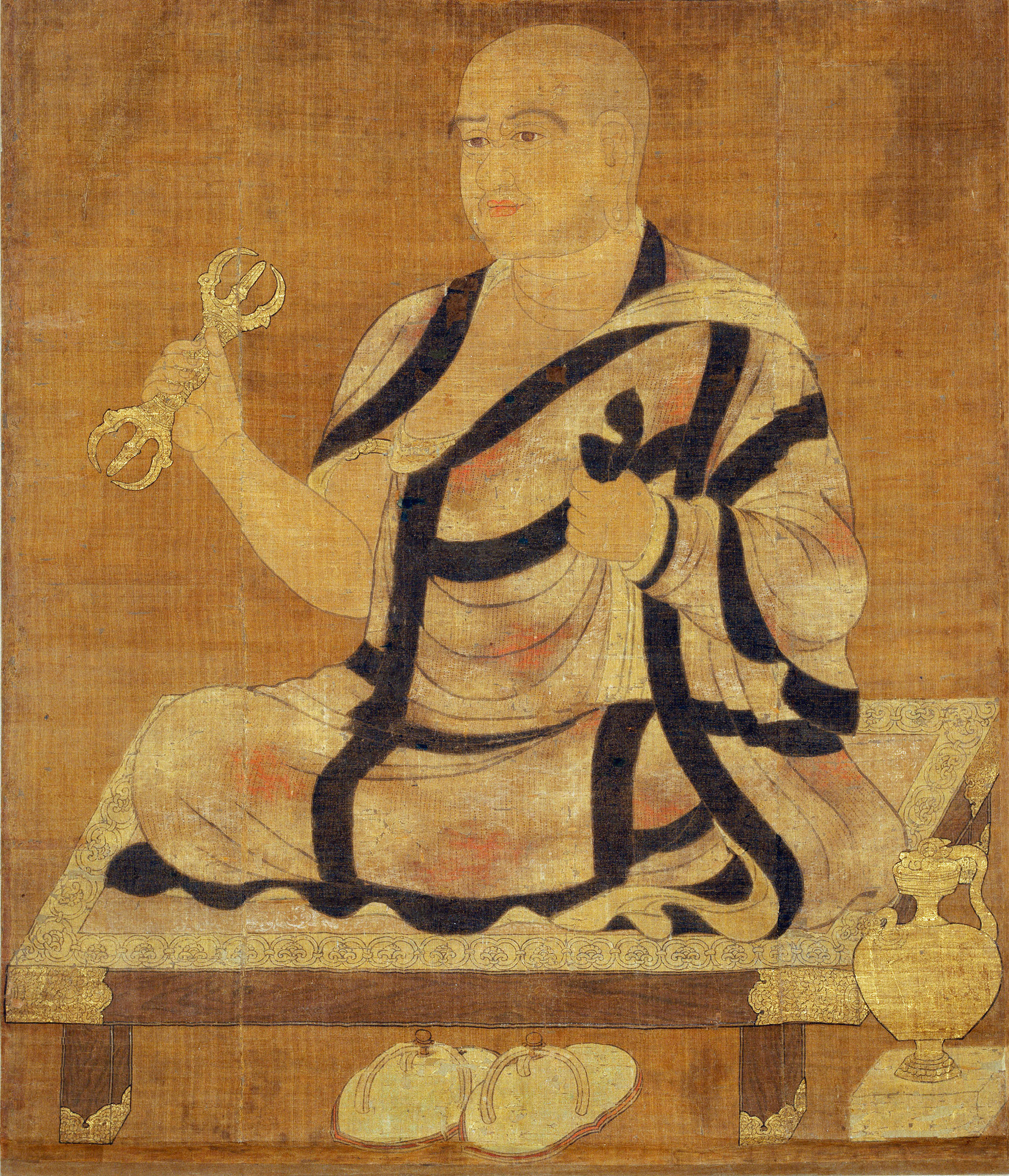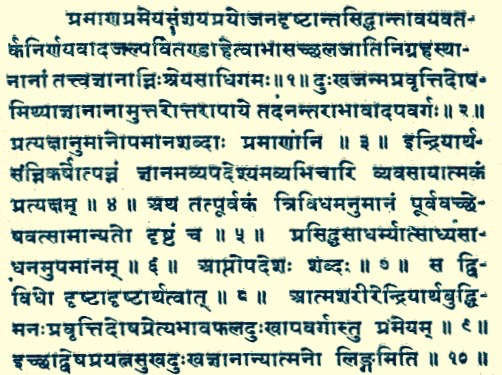|
Hetucakra
''Hetucakra'' or ''Wheel of Reasons'' is a Sanskrit text on logic written by Dignaga (c 480–540 CE). It concerns the application of his 'three modes’ (trairūpya), conditions or aspects of the middle term called ''hetu'' ("reason" for a conclusion) or ''linga'' ("mark", "sign" of a sound argument) in a valid inference within the Indian logico-epistemic tradition, sometimes referred to as Buddhist logic. Anacker's assessment Anacker (2005: p. 34), in introducing his English rendering of the "Method for Argumentation (Vāda-vidhi)" of Vasubandhu (fl. 4th century)—a text composed in Sanskrit which is now only extant in a reconstructed composite extracted from Tibetan works, collated by Frauwallner (1957)—holds that: Vasubandhu's criteria for a valid inference-schema are concise and precise, and there is nothing essential omitted. Dignāga's 'wheel of justifications' (''hetu-cakra''), sometimes held to be the first complete Indian formulation of what constitutes the v ... [...More Info...] [...Related Items...] OR: [Wikipedia] [Google] [Baidu] |
Trairūpya
''Trairūpya (''Sanskrit; English: "the triple-character of inferential sign") is a conceptual tool of Buddhist logic. The Trairūpya, ‘three conditions’, is often accredited to Dignaga (c. 480-540 CE) though is now understood to have originated with his teacher Vasubandhu (fl. 4th century) in the ''Vāda-vidhi'', post-reconstruction of this work by Erich Frauwallner, Frauwallner (1957). Trairūpya is a logical argument that contains three constituents which a logical ‘sign’ or ‘mark’ (linga) must fulfill to be 'valid source of knowledge' (pramana): #It should be present in the case or object under consideration, the ‘subject-locus' (pakṣa) #It should be present in a ‘similar case’ or a homologue (sapakṣa) #It should not be present in any ‘dissimilar case’ or heterologue (vipakṣa) When a ‘sign’ or ‘mark’ (linga) is identified, there are three possibilities: the sign may be present in all, some, or none of the sapakṣas. Likewise, the sign ma ... [...More Info...] [...Related Items...] OR: [Wikipedia] [Google] [Baidu] |
Indian Logic
The development of Indian logic dates back to the Chandahsutra of Pingala and '' anviksiki'' of Medhatithi Gautama (c. 6th century BCE); the Sanskrit grammar rules of Pāṇini (c. 5th century BCE); the Vaisheshika school's analysis of atomism (c. 6th century BCE to 2nd century BCE); the analysis of inference by Gotama (c. 6th century BC to 2nd century CE), founder of the Nyaya school of Hindu philosophy; and the tetralemma of Nagarjuna (c. 2nd century CE). Indian logic stands as one of the three original traditions of logic, alongside the Greek and the Chinese logic. The Indian tradition continued to develop through early to modern times, in the form of the Navya-Nyāya school of logic. Origins The Nasadiya Sukta of the ''Rigveda'' ( RV 10.129) contains ontological speculation in terms of various logical divisions that were later recast formally as the four circles of '' catuskoti'': "A", "not A", "A and 'not A'", and "not A and not not A". Medhatithi Gautama (c. 6th cen ... [...More Info...] [...Related Items...] OR: [Wikipedia] [Google] [Baidu] |
Extant Literature
Ancient literature comprises religious and scientific documents, tales, poetry and plays, royal edicts and declarations, and other forms of writing that were recorded on a variety of media, including stone, clay tablets, papyri, palm leaves, and metal. Before the spread of writing, oral literature did not always survive well, but some texts and fragments have persisted. An unknown number of written works have not survived the ravages of time and are therefore lost. Incomplete list of ancient texts Bronze Age Early Bronze Age: 3rd millennium BC (approximate dates shown). The earliest written literature dates from about 2600 BC (classical Sumerian). Certain literary texts are difficult to date, such as the '' Egyptian Book of the Dead'', which was recorded in the '' Papyrus of Ani'' around 1240 BC, but other versions of the book probably date from about the 18th century BC. * 2600 BC: Sumerian texts from Abu Salabikh, including the '' Instructions of Shuruppak'' and th ... [...More Info...] [...Related Items...] OR: [Wikipedia] [Google] [Baidu] |
History Of Logic
The history of logic deals with the study of the development of the science of valid inference (logic). Formal logics developed in ancient times in Indian logic, India, Logic in China, China, and Greek philosophy, Greece. Greek methods, particularly Aristotelian logic (or term logic) as found in the ''Organon'', found wide application and acceptance in Western science and mathematics for millennia.Boehner p. xiv The Stoicism, Stoics, especially Chrysippus, began the development of predicate logic. Christian philosophy, Christian and Logic in Islamic philosophy, Islamic philosophers such as Boethius (died 524), Avicenna (died 1037), Thomas Aquinas (died 1274) and William of Ockham (died 1347) further developed Aristotle's logic in the Medieval philosophy#High Middle Ages, Middle Ages, reaching a high point in the mid-fourteenth century, with Jean Buridan. The period between the fourteenth century and the beginning of the nineteenth century saw largely decline and neglect, and at le ... [...More Info...] [...Related Items...] OR: [Wikipedia] [Google] [Baidu] |
Buddhist Logic
Buddhist logico-epistemology is a term used in Western scholarship to describe Buddhism, Buddhist systems of ' (Epistemology, epistemic tool, valid cognition) and ' (reasoning, logic). While the term may refer to various Buddhist systems and views on reasoning and epistemology, it is most often used to refer to the work of the "Epistemological school" (Sanskrit: ), i.e. the school of Dignāga, Dignaga and Dharmakirti which developed from the 5th through 7th centuries and remained the main system of Buddhist reasoning until the Decline of Buddhism in the Indian subcontinent, decline of Buddhism in India. The early Buddhist texts show that the Gautama Buddha, historical Buddha was familiar with certain rules of reasoning used for debating purposes and made use of these against his opponents. He also seems to have held certain ideas about epistemology and reasoning, though he did not put forth a logico-epistemological system. The Theravada ''Kathāvatthu'' contains some rules on ... [...More Info...] [...Related Items...] OR: [Wikipedia] [Google] [Baidu] |
Vasubandhu
Vasubandhu (; Tibetan: དབྱིག་གཉེན་ ; floruit, fl. 4th to 5th century CE) was an influential Indian bhikkhu, Buddhist monk and scholar. He was a philosopher who wrote commentary on the Abhidharma, from the perspectives of the Sarvastivada and Sautrāntika schools. After his conversion to Mahayana, Mahayana Buddhism, along with his brother, Asanga, he was also one of the main founders of the Yogacara school. Vasubandhu's ''Abhidharmakośakārikā'' ("Commentary on the Treasury of the Abhidharma") is widely used in Tibetan and East Asian Buddhism, as the major source for non-Mahayana Abhidharma philosophy. His philosophical verse works set forth the standard for the Indian Yogacara metaphysics of "appearance only" (''vijñapti-mātra''), which has been described as a form of "epistemological idealism", Phenomenology (philosophy), phenomenology and close to Immanuel Kant's transcendental idealism. Apart from this, he wrote several commentaries, works on logic, ... [...More Info...] [...Related Items...] OR: [Wikipedia] [Google] [Baidu] |
Erich Frauwallner
Erich Frauwallner (December 28, 1898 – July 5, 1974) was an Austrian professor, a pioneer in the field of Buddhist studies.Walter Slaje: Rezensionen, Stuchlik, Jakob: Der arische Ansatz. Erich Frauwallner und der Nationalsozialismus, Asiatische Studien – Études Asiatiques 64, p. 447–463 (2010PDF/ref>Stuchlik, Replik auf Walter Slajes Rezension meines Buches Der arische Ansatz. Erich Frauwallner und der Nationalsozialismus, Asiatische Studien - Études Asiatiques Bd. 65.1, 287-308 (2011PDF/ref> Career and life Frauwallner studied classical philology and Sanskrit philology in Vienna. He taught Indology from 1928-29 at the University of Vienna. His primary interest was Buddhist logic and epistemology, and later Indian Brahmanic philosophy, with close attention to primary source texts. In 1938 Frauwallner joined the Department of Indian and Iranian philosophy at the Oriental Institute after its Jewish director, Bernhard Geiger, was forced out; Frauwallner became director in ... [...More Info...] [...Related Items...] OR: [Wikipedia] [Google] [Baidu] |
Chakra
A chakra (; ; ) is one of the various focal points used in a variety of ancient meditation practices, collectively denominated as Tantra, part of the inner traditions of Hinduism and Buddhism. The concept of the chakra arose in Hinduism. Beliefs differ between the Indian religions: Buddhist texts mention four or five chakras, while Hindu sources often have six or seven. The modern "Western chakra system" arose from multiple sources, starting in the 1880s with H. P. Blavatsky and other Theosophists, followed by Sir John Woodroffe's 1919 book ''The Serpent Power'', and Charles W. Leadbeater's 1927 book ''The Chakras''. Psychological and other attributes, rainbow colours, and a wide range of correspondences with other systems such as alchemy, astrology, gemstones, homeopathy, Kabbalah and Tarot were added later. Etymology Lexically, ''chakra'' is the Indic reflex of an ancestral Indo-European languages, Indo-European form ''*kʷékʷlos'', whence also "wheel" and "cycl ... [...More Info...] [...Related Items...] OR: [Wikipedia] [Google] [Baidu] |
Nyāya Sūtras
The ''Nyāya Sūtras'' is an ancient Indian Sanskrit text composed by , and the foundational text of the Nyaya school of Hindu philosophy. The date when the text was composed, and the biography of its author is unknown, but variously estimated between 6th-century BCE and 2nd-century CE.Jeaneane Fowler (2002), Perspectives of Reality: An Introduction to the Philosophy of Hinduism, Sussex Academic Press, , page 129 The text may have been composed by more than one author, over a period of time. The text consists of five books, with two chapters in each book, with a cumulative total of 528 aphoristic sutras, about rules of reason, logic, epistemology and metaphysics.Jeaneane Fowler (2002), Perspectives of Reality: An Introduction to the Philosophy of Hinduism, Sussex Academic Press, , pages 127–136 The Nyāya Sūtras is a Hindu text, notable for focusing on knowledge and logic, and making no mention of Vedic rituals. The first book is structured as a general introduction and ... [...More Info...] [...Related Items...] OR: [Wikipedia] [Google] [Baidu] |
Indian Philosophy
Indian philosophy consists of philosophical traditions of the Indian subcontinent. The philosophies are often called darśana meaning, "to see" or "looking at." Ānvīkṣikī means “critical inquiry” or “investigation." Unlike darśana, ānvīkṣikī was used to refer to Indian philosophies by classical Indian philosophers, such as Chanakya in the Arthashastra, Arthaśāstra. A traditional Hindu classification divides āstika and nāstika schools of philosophy, depending on one of three alternate criteria: whether it believes the Vedas as a valid source of knowledge; whether the school believes in the premises of Brahman and Atman (Hinduism), Atman; and whether the school believes in afterlife and Deva (Hinduism), Devas. (though there are exceptions to the latter two: Mimamsa and Samkhya respectively). There are six major (āstika) schools of Hindu philosophy, Vedic philosophy—Nyaya, Vaisheshika, Samkhya, Yoga (philosophy), Yoga, Mīmāṃsā and Vedanta—and five ... [...More Info...] [...Related Items...] OR: [Wikipedia] [Google] [Baidu] |
Madhyamaka
Madhyamaka ("middle way" or "centrism"; ; ; Tibetic languages, Tibetan: དབུ་མ་པ་ ; ''dbu ma pa''), otherwise known as Śūnyavāda ("the Śūnyatā, emptiness doctrine") and Niḥsvabhāvavāda ("the no Svabhava, ''svabhāva'' doctrine"), refers to a tradition of Buddhist philosophy and practice founded by the History of Buddhism in India, Indian Buddhist monk and philosopher Nagarjuna, Nāgārjuna ().Wynne, Alexander (2015) ''Early Buddhist Teaching as Proto-śūnyavāda.'' Journal of the Oxford Centre for Buddhist Studies, 6. pp. 213-241. The foundational text of the Mādhyamaka tradition is Nagarjuna, Nāgārjuna's ''Mūlamadhyamakakārikā'' ("Root Verses on the Middle Way"). More broadly, Madhyamaka also refers to the ultimate nature of phenomena as well as the non-conceptual realization of ultimate reality that is experienced in Buddhist meditation, meditation. Since the 4th century CE onwards, Madhyamaka philosophy had a major influence on the subsequent d ... [...More Info...] [...Related Items...] OR: [Wikipedia] [Google] [Baidu] |






